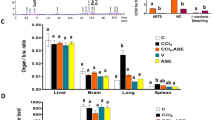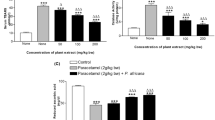Abstract
We investigated the effects of cinnamon water extract supplementation on inflammation and oxidative stress induced by acrylamide in rats. This revealed acrylamide-intoxicated control group had significant higher levels of malondialdehyde, tumor necrosis factor-alpha (TNF-α), high-sensitive C-reactive protein (hs-CRP), leptin and alanine transaminase, and lower levels of total antioxidant capacity compared to the negative control group. In contrast, cinnamon extract administration remedied the levels of total antioxidant capacity, malondialdehyde, TNF-α, hs-CRP, and leptin in the treatment groups. However, there was no significant effect on adiponectin or liver enzymes. This chapter presents a protocol involving production of the acrylamide-induced oxidative stress model, the aqueous extraction of cinnamon powder, and measurement of inflammatory and oxidative stress markers.
Access this chapter
Tax calculation will be finalised at checkout
Purchases are for personal use only
Similar content being viewed by others
References
Mroueh M, Saab Y, Rizkallah R (2004) Hepatoprotective activity of Centaurium erythraea on acetaminophen-induced hepatotoxicity in rats. Phytother Res 18(5):431–433
Ansar S, Siddiqi NJ, Zargar S, Ganaie MA, Abudawood M (2016) Hepatoprotective effect of quercetin supplementation against acrylamide-induced DNA damage in wistar rats. BMC Complement Altern Med 16(1):327. https://doi.org/10.1186/s12906-016-1322-7
Lasekan O, Abbas K (2010) Analysis of volatile flavour compounds and acrylamide in roasted Malaysian tropical almond (Terminalia catappa) nuts using supercritical fluid extraction. Food Chem Toxicol 48(8):2212–2216
Papoušek R, Pataj Z, Nováková P, Lemr K, Barták P (2014) Determination of acrylamide and acrolein in smoke from tobacco and E-cigarettes. Chromatographia 77(17–18):1145–1151
Taubert D, Glöckner R, Müller D, Schömig E (2006) The garlic ingredient diallyl sulfide inhibits cytochrome P450 2E1 dependent bioactivation of acrylamide to glycidamide. Toxicol Lett 164(1):1–5
Hansen SH, Olsen AK, Søderlund EJ, Brunborg G (2010) In vitro investigations of glycidamide-induced DNA lesions in mouse male germ cells and in mouse and human lymphocytes. Mutat Res 696(1):55–61
Watzek N, Scherbl D, Schug M, Hengstler JG, Baum M, Habermeyer M et al (2013) Toxicokinetics of acrylamide in primary rat hepatocytes: coupling to glutathione is faster than conversion to glycidamide. Arch Toxicol 87(8):1545–1556
Zhao M, Wang P, Zhu Y, Liu X, Hu X, Chen F (2015) Blueberry anthocyanins extract inhibits acrylamide-induced diverse toxicity in mice by preventing oxidative stress and cytochrome P450 2E1 activation. J Funct Foods 14:95–101
Septembre-Malaterre A, Le Sage F, Hatia S, Catan A, Janci L, Gonthier MP (2016) Curcuma longa polyphenols improve insulin-mediated lipid accumulation and attenuate proinflammatory response of 3T3-L1 adipose cells during oxidative stress through regulation of key adipokines and antioxidant enzymes. Biofactors 42(4):418–430
Alturfan AA, Tozan-Beceren A, Şehirli AÖ, Demiralp E, Şener G, Omurtag GZ (2012) Resveratrol ameliorates oxidative DNA damage and protects against acrylamide-induced oxidative stress in rats. Mol Biol Rep 39(4):4589–4596
Liu S, Jiang L, Zhong T, Kong S, Zheng R, Kong F et al (2015) Effect of acrylamide on oocyte nuclear maturation and cumulus cells apoptosis in mouse in vitro. PLoS One 10(8):e0135818. https://doi.org/10.1371/journal.pone.0135818
Jiang L, Cao J, An Y, Geng C, Qu S, Jiang L et al (2007) Genotoxicity of acrylamide in human hepatoma G2 (HepG2) cells. Toxicol In Vitro 21(8):1486–1492
Goffeng LO, Kjuus H, Heier MS, Alvestrand M, Ulvestad B, Skaug V (2008) Colour vision and light sensitivity in tunnel workers previously exposed to acrylamide and N-methylolacrylamide containing grouting agents. Neurotoxicology 29(1):31–39
Braithwaite I, Stewart AW, Hancox RJ, Beasley R, Murphy R, Mitchell EA et al (2014) Fast-food consumption and body mass index in children and adolescents: an international cross-sectional study. BMJ Open 4(12):e005813. https://doi.org/10.1136/bmjopen-2014-005813
Einstein A, Podolsky B, Rosen N (1935) Can quantum-mechanical description of physical reality be considered complete? Phys Rev 47(10):777–780. http://inters.org/files/einsteinetal1935.pdf
Mohamed Sham Shihabudeen H, Hansi Priscilla D, Thirumurugan K (2011) Cinnamon extract inhibits α-glucosidase activity and dampens postprandial glucose excursion in diabetic rats. Nutr Metab (Lond) 8(1):46. https://doi.org/10.1186/1743-7075-8-46
El-Baroty GS, El-Baky HA, Farag R, Saleh MA (2010) Characterization of antioxidant and antimicrobial compounds of cinnamon and ginger essential oils. Afr J Biochem Res 4(6):167–174
Hagenlocher Y, Hösel A, Bischoff SC, Lorentz A (2016) Cinnamon extract reduces symptoms, inflammatory mediators and mast cell markers in murine IL-10−/− colitis. J Nutr Biochem 30:85–92
Roussel AM, Hininger I, Benaraba R, Ziegenfuss TN, Anderson RA (2009) Antioxidant effects of a cinnamon extract in people with impaired fasting glucose that are overweight or obese. J Am Coll Nutr 28(1):16–21
Zhang K, Han ES, Dellinger TH, Lu J, Nam S, Anderson RA et al (2016) Cinnamon extract reduces VEGF expression via suppressing HIF-1α gene expression and inhibits tumor growth in mice. Mol Carcinog 56(2):436–446
Eidi A, Mortazavi P, Bazargan M, Zaringhalam J (2012) Hepatoprotective activity of cinnamon ethanolic extract against CCL 4-induced liver injury in rats. EXCLI J 11:495–507
Gaique TG, Lopes BP, Souza LL, Paula GS, Pazos-Moura CC, Oliveira KJ (2015) Cinnamon intake reduces serum T3 level and modulates tissue-specific expression of thyroid hormone receptor and target genes in rats. J Sci Food Agric 96(8):2889–2895
Haidari F, Omidian K, Rafiei H, Zarei M, MohamadShahi M (2013) Green tea (Camellia sinensis) supplementation to diabetic rats improves serum and hepatic oxidative stress markers. Iran J Pharm Res 12(1):109–114
Gunawardena D, Karunaweera N, Lee S, van Der Kooy F, Harman DG, Raju R et al (2015) Anti-inflammatory activity of cinnamon (C. zeylanicum and C. cassia) extracts–identification of E-cinnamaldehyde and o-methoxycinnamaldehyde as the most potent bioactive compounds. Food Funct 6(3):910–919
Dehghan G, Shaghaghi M, Jafari A, Mohammadi M, Badalzadeh R (2014) Effect of endurance training and cinnamon supplementation on post-exercise oxidative responses in rats. Mol Biol Res Commun 3(4):269–281
Wang F, Pu C, Zhou P, Wang P, Liang D, Wang Q et al (2015) Cinnamaldehyde prevents endothelial dysfunction induced by high glucose by activating nrf2. Cell Physiol Biochem 36(1):315–324
Shihabudeen HMS, Priscilla DH, Thirumurugan K (2011) Cinnamon extract inhibits α-glucosidase activity and dampens postprandial glucose excursion in diabetic rats. Nutr Metab (Lond) 8(1):46. https://doi.org/10.1186/1743-7075-8-46
Kokanova-Nedialkova Z, Nedialkov P, Kondeva-Burdina M, Simenova R, Tsankova V, Nikolov S (2016) Good king-Henry (Chenopodium bonus-henricus L.)—a source of hepatoprotective flavonoids. Planta Med 81(S 01):S1–S381. https://doi.org/10.1055/s-0036-1596856
Wang GW, Deng LQ, Luo YP, Liao ZH, Chen M (2016) Hepatoprotective triterpenoids and lignans from the stems of Schisandra pubescens. Nat Prod Res 31(16):1855–1860
Zheng YF, Wei JH, Fang SQ, Tang YP, Cheng HB, Wang TL et al (2015) Hepatoprotectivetriterpenesaponins from the roots of Glycyrrhizainflata. Molecules 20(4):6273–6283
Raj VP, Chandrasekhar RH, Vijayan P, Dhanaraj S, Rao MC, Rao VJ et al (2010) In vitro and in vivo hepatoprotective effects of the total alkaloid fraction of Hygrophilaauriculata leaves. Indian J Pharmacol 42(2):99–104
Koochaksaraie R, Irani M, Gharavysi S (2011) The effects of cinnamon powder feeding on some blood metabolites in broiler chicks. Rev Bras Ciênc Avíc 13(3):197–202
Wickenberg J, Lindstedt S, Nilsson J, Hlebowicz J (2014) Cassia cinnamon does not change the insulin sensitivity or the liver enzymes in subjects with impaired glucose tolerance. Nutr J 13(1):1. https://doi.org/10.1186/1475-2891-13-96
Lu T, Sheng H, Wu J, Cheng Y, Zhu J, Chen Y (2012) Cinnamon extract improves fasting blood glucose and glycosylated hemoglobin level in Chinese patients with type 2 diabetes. Nutr Res 32(6):408–412
Askari F, Rashidkhani B, Hekmatdoost A (2014) Cinnamon may have therapeutic benefits on lipid profile, liver enzymes, insulin resistance, and high-sensitivity C-reactive protein in nonalcoholic fatty liver disease patients. Nutr Res 34(2):143–148
Amin KA, El-Twab A (2009) Oxidative markers, nitric oxide and homocysteine alteration in hypercholesterolimic rats: role of atorvastatine and cinnamon. Int J Clin Exp Med 2(3):254–265
Moselhy SS, Ali HK (2009) Hepatoprotective effect of cinnamon extracts against carbon tetrachloride induced oxidative stress and liver injury in rats. Biol Res 42(1):93–98
Acknowledgments
This work was financially supported by a grant from Nutrition and Metabolic Disease Research Center, Ahvaz Jundishapur University of Medical Sciences (Grant Number: NRC-9414).
Author information
Authors and Affiliations
Editor information
Editors and Affiliations
Rights and permissions
Copyright information
© 2022 The Author(s), under exclusive license to Springer Science+Business Media, LLC, part of Springer Nature
About this protocol
Cite this protocol
Haidari, F., Mohammadshahi, M., Abiri, B., Guest, P.C., Zarei, M., Fathi, M. (2022). Testing the Effects of Cinnamon Extract Supplementation on Inflammation and Oxidative Stress Induced by Acrylamide. In: Guest, P.C. (eds) Physical Exercise and Natural and Synthetic Products in Health and Disease. Methods in Molecular Biology, vol 2343. Humana, New York, NY. https://doi.org/10.1007/978-1-0716-1558-4_11
Download citation
DOI: https://doi.org/10.1007/978-1-0716-1558-4_11
Published:
Publisher Name: Humana, New York, NY
Print ISBN: 978-1-0716-1557-7
Online ISBN: 978-1-0716-1558-4
eBook Packages: Springer Protocols




